Civic Engagement Cumulative Exam
1/97
There's no tags or description
Looks like no tags are added yet.
Name | Mastery | Learn | Test | Matching | Spaced |
|---|
No study sessions yet.
98 Terms
Refers to the ways in which citizens participate in the life of a community in order to improve conditions for others or to help shape the community’s future.
Can take many forms, from individual volunteerism, to organizational involvement, to electoral participation.
It can include efforts to directly address an issue, work with others in a community to solve a problem, or interact with government institutions.
What is ‘civic engagement’?
True
It involves working to make a difference in the civic life of one’s community.
Allows you to develop the combination of knowledge, skills, values, and motivation to make that difference.
True civic engagement allows us to work with the people in our community and collaborate to imagine how it might look different, to challenge power, dismantle it, and change the world.
True or False: civic engagement is action-oriented.
Plays a valuable role in shaping how we learn to interact with our community and develop the sense of empowerment necessary to become active citizens.
Support people and causes in our community and improve the quality of life for others.
Can give you a chance to develop new skills and team up with a diverse group of people.
How does volunteering help us with civic engagement?
More than half.
Many more rely on volunteers to supplement staff.
12.7 million volunteers contribute close to 2 billion hours.
How many of Canada’s 170,000 non-profit and charitable organizations have no paid staff and rely solely on volunteers?
Any non-profit organization that exists to perpetuate itself.
Ex: Philanthropy. The way philanthropic funds are spent produce very surface level change. For example, it makes poverty more “manageable” for the people effected, rather than acting to eradicate it entirely. The same methods are employed time and time again, despite yielding lackluster results, because there are entire industries that rely on the perpetuation of social issues.
An example of an industrial complex, NOT a non-profit industrial complex, is the military. “The military industrial complex doesn’t exist to create peace; it has to have war in order to exist.” (0:10)
What is the ‘non-profit industrial complex’?
A critical approach to social justice refers to specific theoretical perspectives that recognize that society is stratified (i.e., divided and unequal) in significant and far-reaching ways along social group lines that include race, class, gender, sexuality, and ability. (via newdiscourses)
Along social group lines that include class, race, gender, sexuality, and ability.
Recognizes inequality and injustice as structural in nature and seeks to change this.
Being civically engaged requires us to think about the problems in our world and how we might go about fixing them But in whose image should the world be changed? This is why we need the concept of social justice.
Using a Critical Social Justice lens, we will learn how privilege, oppression, power, and economic and political forces shape our world and how it may come to change.
What is ‘critical social justice’, and why do we need it?
Everyone operates from a basic theory about how the world works. Most of us don’t consider this when forming our opinions about the world and so we lack theoretical consistency.
Social justice advocates need to be able to argue well. Having a consistent and logically sound theoretical foundation allows us to do this.
Consider on whom the responsibility falls, the individual, or the collective? The government?
Why do we have to have a strong theoretical foundation to be consistent in how we view the world and apply concepts to it?
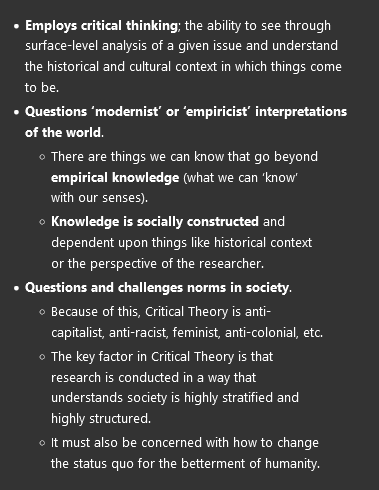
Employs critical thinking; the ability to see through surface-level analysis of a given issue and understand the historical and cultural context in which things come to be.
Questions ‘modernist’ or ‘empiricist’ interpretations of the world.
There are things we can know that go beyond empirical knowledge (what we can ‘know’ with our senses).
Knowledge is socially constructed and dependent upon things like historical context or the perspective of the researcher.
Questions and challenges norms in society.
Because of this, Critical Theory is anti-capitalist, anti-racist, feminist, anti-colonial, etc.
The key factor in Critical Theory is that research is conducted in a way that understands society is highly stratified and highly structured.
It must also be concerned with how to change the status quo for the betterment of humanity.
How do we define “critical” in theoretical tradition?
No one perspective is right or wrong—they are both right depending on one’s perspective and understanding of the world.
However, this surface level reading of the parable misses a crucial aspect— power
What was the lesson behind Hodja and The Foreigner?
NOTE: I tried so hard to look for a video, but I couldn’t find one, nor the one we used in class, and the slides for this week were only accessible in PDF format :(
A theoretical perspective which aims to critique, challenge, and reorganize dominant institutions in a manner which emphasizes justice for those who have been historically marginalized and oppressed. Specifically, Marxism critiques, challenges, and seeks to deconstruct capitalism as the central organizing structure of our society and replace it with a more egalitarian, just, and fair system.
The capitalists profit off the surplus value of labour provided by the workers. This exploitation is at the root of the capitalist system.
The world is divided largely into two classes, the
bourgeoisie and the proletariat— the capitalist class and the working class.
The bourgeoisie own the means of production. The
proletariat subsists only by receiving wages for work.
What is ‘Marxism’?
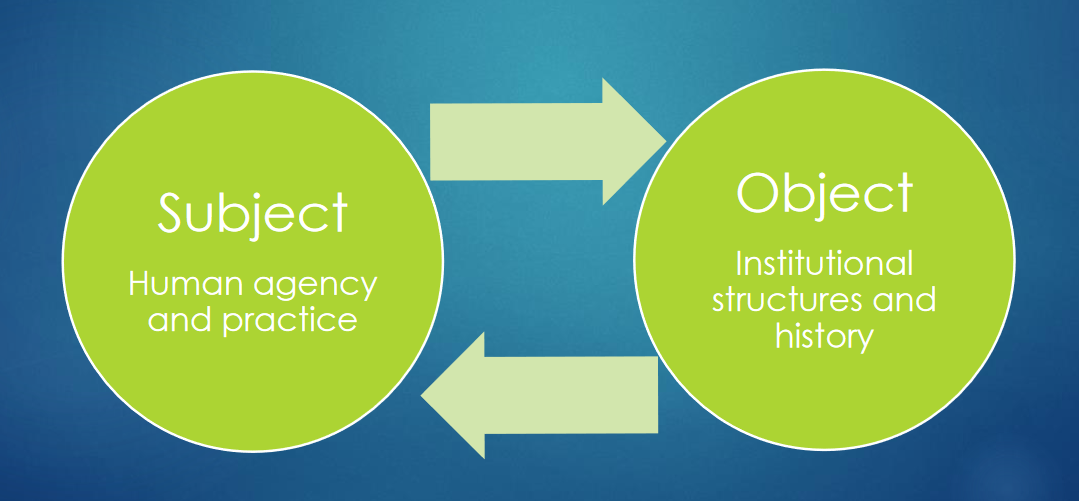
Regular and mutual relationships, interactions, and processes in nature, society, and human thought. A dialectical relationship is a relationship in which two phenomena or ideas mutually impact each other, leading to development and negation. (Wikipedia)
Critical theorists borrow from this theory to understand how societies change.
What is the ‘dialectic’?
A sociopolitical educative tool that engages learners in questioning the nature of their historical and social situation, which Freire addressed as "reading the world". (Wikipedia)
With a critical consciousness, we can perceive social reality “not as a closed world from which there is no exit, but as a limiting system which we can transform.”
What is a ‘critical consciousness’, according to Paolo Friere?
Understanding this allows us to not just diagnose problems with society, but allows us to imagine how it might be different and to actively work toward that goal.
It’s not as easy to say “racism is bad and perpetuated by racist people.” Social injustice lies much deeper than that. It is institutional, systemic, deeply embedded- built into the fabric of the system.
CSJ looks past anecdotal evidence and examines patterns and structures and actively looks to challenge, dismantle and replace those structures.
What does critical social justice do to our ability to view the world and its problems?
Refers to market-oriented reform policies such as "eliminating price controls, deregulating capital markets, lowering trade barriers" and reducing, especially through privatization and austerity, state influence in the economy. (Wikipedia)
All societies are constrained by the limitations of their epoch (a period of time in history or a person's life, typically one marked by notable events or particular characteristics. via Oxford Languages) or relation to the mode of production. Think for example of feudalism, colonial slavery, early capitalism, tribal, nomadic, etc.
Each form of society is guided by a hegemonic (dominant) philosophy which sets the tone and range of activities for all government, corporate, and social realms.
What is ‘neoliberalism’?
False.
Liberalism, at least in North America, is a strategy with the aim of reducing or preventing social conflict.
It is presented as “progressive” or “leftist” compared to conservative or right-wing ideologies. In reality, political liberalism is largely “status quo” politics and does not represent progressive or leftist ideals in their truest sense
The root of neoliberalism is economic liberalism, which is not the same as political liberalism.
Conservative politicians who say they “hate liberals” are referring to political liberals. In economics, most of those same conservatives would be considered economic liberals or neoliberals.
True or False: The term ‘neoliberalism’ is interchangeable with ‘political liberalism’.
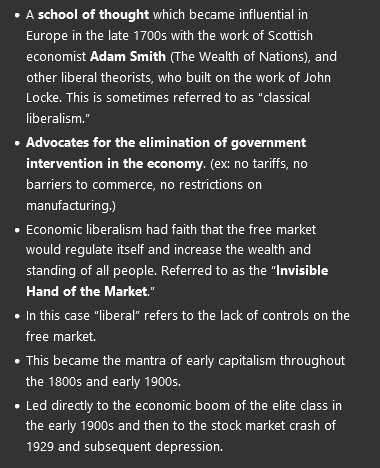
A school of thought which became influential in Europe in the late 1700s with the work of Scottish economist Adam Smith (The Wealth of Nations), and other liberal theorists, who built on the work of John Locke. This is sometimes referred to as “classical liberalism.”
Advocates for the elimination of government intervention in the economy. (ex: no tariffs, no barriers to commerce, no restrictions on manufacturing.)
Economic liberalism had faith that the free market would regulate itself and increase the wealth and standing of all people. Referred to as the “Invisible Hand of the Market.”
In this case “liberal” refers to the lack of controls on the free market.
This became the mantra of early capitalism throughout the 1800s and early 1900s.
Led directly to the economic boom of the elite class in the early 1900s and then to the stock market crash of 1929 and subsequent depression.
What is ‘economic liberalism’?
British economist John Maynard Keynes recognized that liberalism was not the best formulation for capitalism to thrive. Instead, Keynes suggested that full employment is necessary for capitalism to grow.
Full employment would never happen under liberal economics and must therefore be controlled by governments and central banks.
Keynesian Economics had a heavy influence on U.S. President Franklin Delano Roosevelt’s “New Deal” which emphasized the government’s role in advancing the common good while retaining capitalism as the central economic organizer of American society
Strengthened and encouraged a unionized workforce which minimize rampant inequality (though it still had its prejudiced exclusions).
What is ‘embedded liberalism’ or ‘Keynesian era liberalism’?
Economic liberalism.
A concerted effort by the corporate and political elite to return to the glory days of liberalism, where decreased workers’ rights and a focus on the highest possible profit would mean a better life for the rich and powerful.
Upheld by powerful financial institutions such as the International Monetary Fund (IMF), the World Bank, and trade agreements (NAFTA, WTO, TPP, etc.) which lessen the power of governments and citizens to fight back against corporatists.
Neoliberalism has become the dominant (or hegemonic) ideology of modern capitalism. It has become such a prevalent and ingrained ideology that it stretches beyond macro-economics and into the personal, often even masquerading as progressive movements.
Which economic ideology was neoliberalism an attempt to return to?
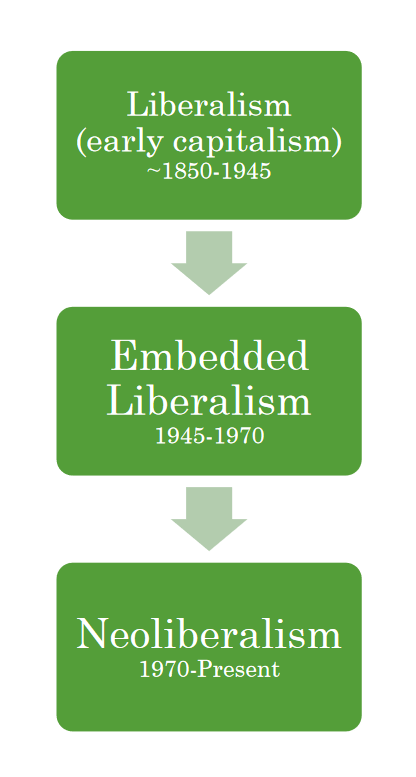
Liberalism → Embedded Liberalism → Neoliberalism
Liberalism: Created massive wealth, but also rampant inequality. This inequality was a major factor in the depth of the depression.
Embedded Liberalism (Keynesian Economics): Due to the depression, labour activists, workers, and the administration of Franklin Delano Roosevelt in the U.S. shifted away from unfettered free market control of the economy. Measures were put in place to strengthen the working class and to stifle inequality while still operating in a broadly capitalist system.
What were the three phases of capitalism?
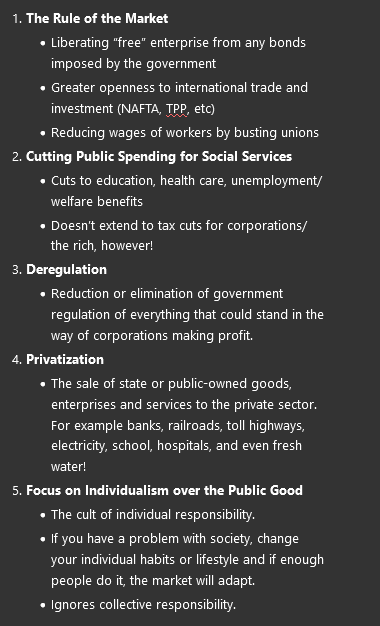
The Rule of the Market
Liberating “free” enterprise from any bonds imposed by the government
Greater openness to international trade and investment (NAFTA, TPP, etc)
Reducing wages of workers by busting unions
Cutting Public Spending for Social Services
Cuts to education, health care, unemployment/welfare benefits
Doesn’t extend to tax cuts for corporations/the rich, however!
Deregulation
Reduction or elimination of government regulation of everything that could stand in the way of corporations making profit.
Privatization
The sale of state or public-owned goods, enterprises and services to the private sector. For example banks, railroads, toll highways, electricity, school, hospitals, and even fresh water!
Focus on Individualism over the Public Good
The cult of individual responsibility.
If you have a problem with society, change your individual habits or lifestyle and if enough people do it, the market will adapt.
Ignores collective responsibility.
What are the five main tenets of neoliberalism?
Neoliberalism has moved beyond the realm of economics and political life and has penetrated the very way we construct ourselves as human subjects. (Suggested by Wendy Brown, following the lead of Michel Foucault.)
Brown argues that a key tenet of modern neoliberalism is its ability to apply the model of the market to every domain of human existence— even where money is not an issue.
For Brown, under neoliberalism, we think and act like contemporary market subjects. (Ex: education, health, fitness, family life, neighbourhood, dating life, etc.)
Neoliberal rationality does not necessarily marketize all spheres of human interaction, although that is an important dimension of the philosophy. Rather, neoliberal rationality propagates the model of the market to all domains and activities. It makes us market actors, always, only, and everywhere.
What is ‘neoliberal rationality’?
Started in 2021 in Buffalo, NY – various stores formed a union under the IWW.
Has now spread to over 490 stores and over 10,000 workers across the U.S. and Canada.
Fights short-staffing, low wages, unpredictable scheduling, harassment, and more.
Starbucks has had a relentless, years long union busting campaign that has cost them over a quarter billion dollars. (But hey, you don’t need a union).
In spite of all its claims to be a “woke” workplace, Starbucks has shown repeatedly it will clamp down on its already underpaid, overworked workforce.
This two-faced approach is emblematic of neoliberalism in 2024 and exists across all industries.
What is ‘Starbucks Workers United’?
We vote for:
Federal Elections (sort of)
Provincial Elections (sort of)
Municipal Elections
Referenda (referendum: a general vote by the electorate on a single political question that has been referred to them for a direct decision. via Oxford Languages)
We DON’T we vote for:
Senate
Cabinet
Governor General
Economic system
What do we vote for in Canada? What do we NOT vote for?
![<ul><li><p><span><strong>The Crown</strong>: Canada is a Constitutional Monarchy</span></p></li><li><p><span><strong>Legislative Branch</strong>: Consists of the Senate and the House of Commons</span></p></li><li><p><span><strong>House of Commons</strong>: this is the only thing we vote on federally (made up of Members of Parliament [MPs])</span></p></li><li><p><span><strong>Senate</strong>: appointed by the PM (usually), through the GG. Mandatory retirement at 75.</span></p></li></ul><div data-youtube-video=""><iframe width="640" height="480" allowfullscreen="true" autoplay="false" disablekbcontrols="false" enableiframeapi="false" endtime="0" ivloadpolicy="0" loop="false" modestbranding="false" origin="" playlist="" src="https://www.youtube.com/embed/7C8uDuhLqvg?si=gFCNqd58fCnUz3Ku" start="0"></iframe></div><p></p>](https://knowt-user-attachments.s3.amazonaws.com/43c48b49-970f-42c7-a1b3-11853e7befa1.png)
The Crown: Canada is a Constitutional Monarchy
Legislative Branch: Consists of the Senate and the House of Commons
House of Commons: this is the only thing we vote on federally (made up of Members of Parliament [MPs])
Senate: appointed by the PM (usually), through the GG. Mandatory retirement at 75.
What does the structure of the federal government look like?
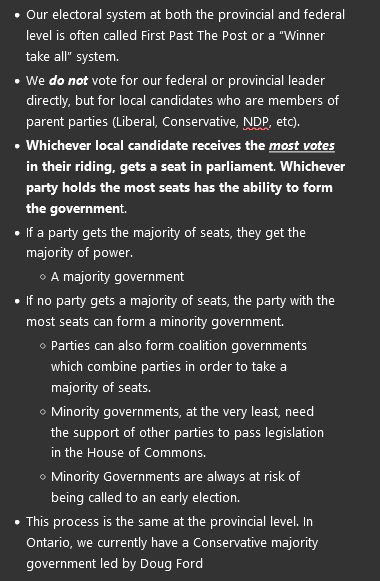
Our electoral system at both the provincial and federal level is often called First Past The Post or a “Winner take all” system.
We do not vote for our federal or provincial leader directly, but for local candidates who are members of parent parties (Liberal, Conservative, NDP, etc).
Whichever local candidate receives the most votes in their riding, gets a seat in parliament. Whichever party holds the most seats has the ability to form the government.
If a party gets the majority of seats, they get the majority of power.
A majority government
If no party gets a majority of seats, the party with the most seats can form a minority government.
Parties can also form coalition governments which combine parties in order to take a majority of seats.
Minority governments, at the very least, need the support of other parties to pass legislation in the House of Commons.
Minority Governments are always at risk of being called to an early election.
This process is the same at the provincial level. In Ontario, we currently have a Conservative majority government led by Doug Ford
What is ‘First Past the Post (FPTP)’ or a ‘Westminster Parliamentary System’?
In 2021, the Federal Liberals failed to gain enough seats to form a majority government, so had to appeal to one of the opposition parties to join then in a “confidence” vote. In this case, the NDP did that, forming a confidence agreement giving them 185 seats in total.
In this case, the NDP and Liberals had to negotiate on the kinds of things the Liberals needed to do to keep the NDP on their side. Federal dental care and pharmacare plans were the biggest things.
What often happens when the winning party wins a minority government?
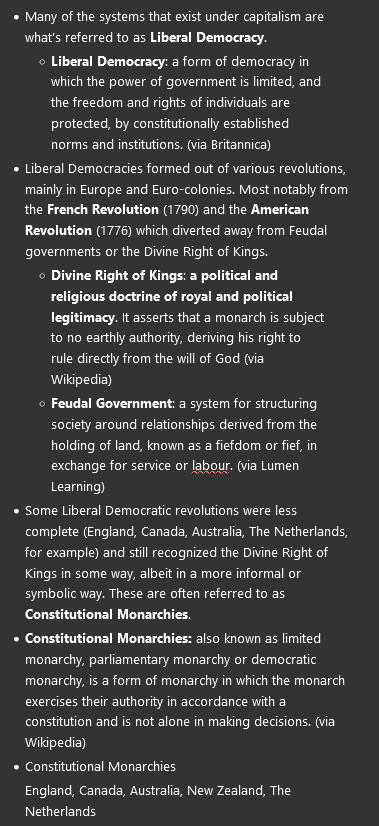
Many of the systems that exist under capitalism are what’s referred to as Liberal Democracy.
Liberal Democracy: a form of democracy in which the power of government is limited, and the freedom and rights of individuals are protected, by constitutionally established norms and institutions. (via Britannica)
Liberal Democracies formed out of various revolutions, mainly in Europe and Euro-colonies. Most notably from the French Revolution (1790) and the American Revolution (1776) which diverted away from Feudal governments or the Divine Right of Kings.
Divine Right of Kings: a political and religious doctrine of royal and political legitimacy. It asserts that a monarch is subject to no earthly authority, deriving his right to rule directly from the will of God (via Wikipedia)
Feudal Government: a system for structuring society around relationships derived from the holding of land, known as a fiefdom or fief, in exchange for service or labour. (via Lumen Learning)
Some Liberal Democratic revolutions were less complete (England, Canada, Australia, The Netherlands, for example) and still recognized the Divine Right of Kings in some way, albeit in a more informal or symbolic way. These are often referred to as Constitutional Monarchies.
Constitutional Monarchies: also known as limited monarchy, parliamentary monarchy or democratic monarchy, is a form of monarchy in which the monarch exercises their authority in accordance with a constitution and is not alone in making decisions. (via Wikipedia)
Constitutional Monarchies
England, Canada, Australia, New Zealand, The Netherlands
What is a ‘liberal democracy’?
A state where the chief executive and representatives are elected, and the rules are set down in a written constitution.
Constitutional Republic
No recognition of Divine Right of Kings
USA, France, Germany, Russia (there are vast differences in types of government here)
USA – Republic/Electoral College
France – Unitary, semi-presidential state
Germany – Parliamentary Republic
What is a ‘constitutional republic’?
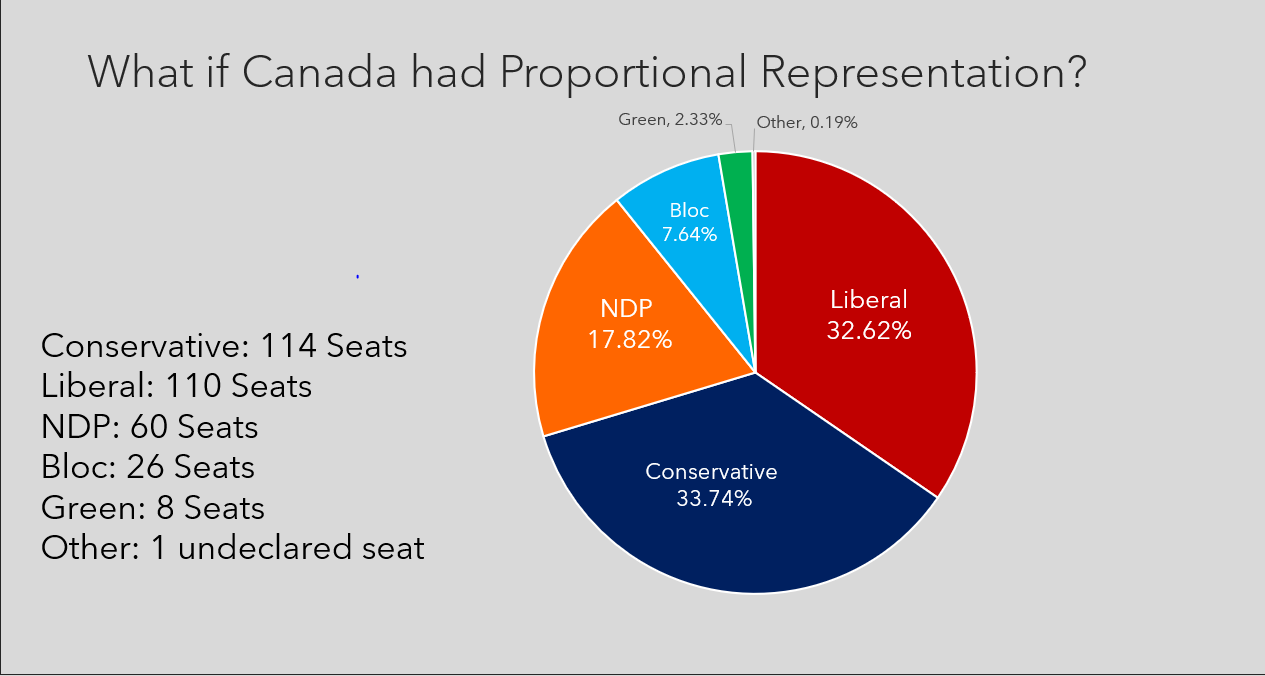
Any type of electoral system under which subgroups of an electorate are reflected proportionately in the elected body. (Wikipedia)
The concept applies mainly to political divisions (political parties) among voters. The essence of such systems is that all votes cast – or almost all votes cast – contribute to the result and are effectively used to help elect someone. (Wikipedia)
Under other election systems, a bare plurality or a scant majority are all that are used to elect candidates. PR systems provide balanced representation to different factions, reflecting how votes are cast. (Wikipedia)
Exists in some forms in Australia
Albania, Argentina, Costa Rica, Denmark, Germany, Greece, Iceland, Ireland, Netherlands (partial), Norway, Portugal, Spain, Sweden, Turkey, and many others.
What is a ‘proportional representation’?
If you voted and your local riding candidate did not win, your vote was “dead” since the winner takes all in each riding.
Nationally, 50.9% of all votes cast were dead
Atlantic Canada – 56.2%
Quebec – 54.2%
Ontario – 53.1%
Western/Northern Canada – 44.6%
36% of ridings had a candidate with over 50% of the vote.
19% had less than 40%
2 ridings had less than 30%
What is a ‘dead vote’?
There are many cogent arguments which claim voting is one of the least important things you can do to implement social change.
History shows us that progressive social change (i.e. social change not ushered in by the wealthy or powerful) is only achieved by grassroots movements and direct action which force politicians and others in power to execute the will of the people
The eradication of feudalism
Civil rights movement
Women’s rights movements
The right to access abortion, equal pay, etc.
Universal Health Care in Canada
Labour Rights
How much does voting actually do?
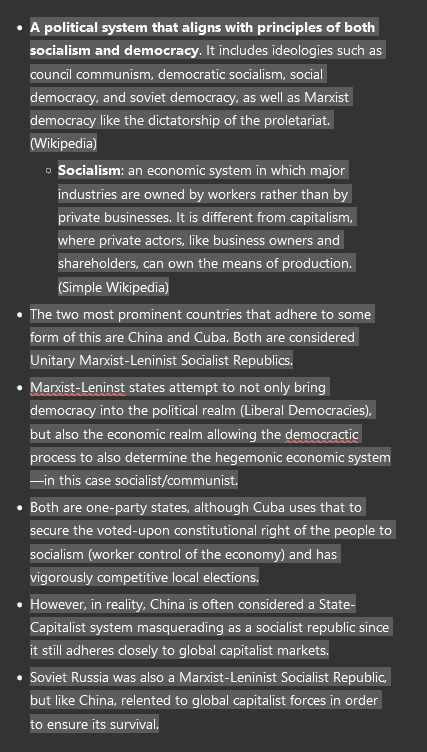
A political system that aligns with principles of both socialism and democracy. It includes ideologies such as council communism, democratic socialism, social democracy, and soviet democracy, as well as Marxist democracy like the dictatorship of the proletariat. (Wikipedia)
Socialism: an economic system in which major industries are owned by workers rather than by private businesses. It is different from capitalism, where private actors, like business owners and shareholders, can own the means of production. (Simple Wikipedia)
The two most prominent countries that adhere to some form of this are China and Cuba. Both are considered Unitary Marxist-Leninist Socialist Republics.
Marxist-Leninst states attempt to not only bring democracy into the political realm (Liberal Democracies), but also the economic realm allowing the democractic process to also determine the hegemonic economic system—in this case socialist/communist.
Both are one-party states, although Cuba uses that to secure the voted-upon constitutional right of the people to socialism (worker control of the economy) and has vigorously competitive local elections.
However, in reality, China is often considered a State-Capitalist system masquerading as a socialist republic since it still adheres closely to global capitalist markets.
Soviet Russia was also a Marxist-Leninist Socialist Republic, but like China, relented to global capitalist forces in order to ensure its survival.
What is a ‘socialist democracy’?
Unlike Provincial and Federal elections, local municipal elections are a form of more direct democracy since you vote for both a hyper-local councilor AND the mayor directly.
However, Doug Ford has given strong mayor powers to a few of the more populous regions in Ontario which heavily nullifies the role of councilors in decision-making.
Typically, councilors (at least in sizable cities and towns) come from specific wards in the city.
Smaller towns usually elect a certain number of councilors by cascading vote.
What is unique about municipal elections?
Political parties in Canada do not represent the full range of political choice.
Not voting demonstrates a lack of confidence in or knowledge of the democratic system.
Even voter apathy is an important data point
If voters are apathetic or do not have the time/energy to engage in the system, that tells us that neoliberal capitalism is not providing people the tools or capacity to consider electoral politics important to them.
Why is NOT voting an act of civic engagement?
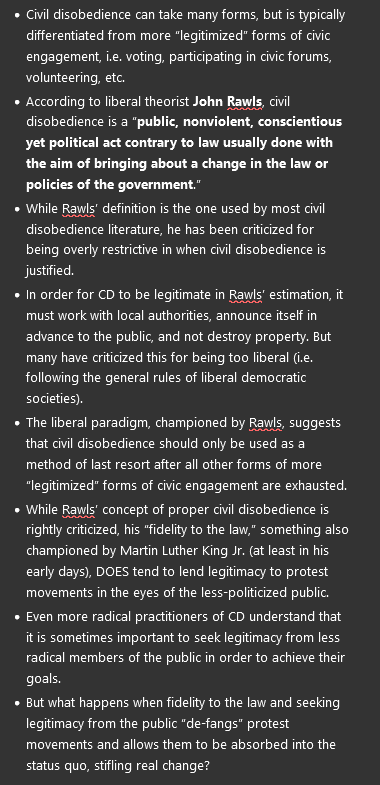
Civil disobedience can take many forms, but is typically differentiated from more “legitimized” forms of civic engagement, i.e. voting, participating in civic forums, volunteering, etc.
According to liberal theorist John Rawls, civil disobedience is a “public, nonviolent, conscientious yet political act contrary to law usually done with the aim of bringing about a change in the law or policies of the government.”
While Rawls’ definition is the one used by most civil disobedience literature, he has been criticized for being overly restrictive in when civil disobedience is justified.
In order for CD to be legitimate in Rawls’ estimation, it must work with local authorities, announce itself in advance to the public, and not destroy property. But many have criticized this for being too liberal (i.e. following the general rules of liberal democratic societies).
The liberal paradigm, championed by Rawls, suggests that civil disobedience should only be used as a method of last resort after all other forms of more “legitimized” forms of civic engagement are exhausted.
While Rawls’ concept of proper civil disobedience is rightly criticized, his “fidelity to the law,” something also championed by Martin Luther King Jr. (at least in his early days), DOES tend to lend legitimacy to protest movements in the eyes of the less-politicized public.
Even more radical practitioners of CD understand that it is sometimes important to seek legitimacy from less radical members of the public in order to achieve their goals.
But what happens when fidelity to the law and seeking legitimacy from the public “de-fangs” protest movements and allows them to be absorbed into the status quo, stifling real change?
What is ‘civil disobedience’?
Liberal protest movements tend to get absorbed into the very power structures they’re looking to change, leading to reformist or surface changes at best and to no change or a regressive situation at worst.
For Rawls and other liberal CD theorists, CD should be limited to the realm of the political and never become about economic reforms since legitimacy is difficult to suss out because those acting on economic issues could be “self-interested.” But of course, this limiting of what legitimate CD is, reinforces….
…CAPITALISM AS THE ONLY TRUE AND RIGHTEOUS ECONOMIC SYSTEM and instead focuses on issues of individual identity and equal liberty.
How much legitimacy for civil disobedience should be sought, and from who?
Yes.
Candice Delmas argues that citizens have a civic duty to disobey unjust laws and institutions and that it ought not to be civil.
She says “covert, evasive, violent, or offensive” uncivil disobedience can also be legitimate, especially if the target of such uncivil acts has a deleterious effect on the majority of people.
“…liberal (and sometimes more radical) civil disobedience offers a way of doing disruptive protest in a way that has the potential to be broadly accepted as legitimate, because of how it relates to the state, democracy, and the rule of law within a largely reformist framework with little to say about political economy.” (Berglund, pg. 4, emphasis mine)
Can UNcivilized disobedience be considered “legitimate”?
No.
Rosa Luxemburg argued in her 1899 pamphlet “Social Reform or Revolution” that while social reforms can help working people gain class consciousness, they ultimately cannot liberate the working class from the oppressions of capitalism.
She argued that the working class must recognize that capitalism creates the seeds for its own destruction and that revolution is necessary to transform capitalism into socialism.
Social reform: reshaping and reforming culturally accepted laws and norms in light of new cultural paradigms. (study.com)
Revolution: a sudden, radical, or complete change; a fundamental change in political organization. (Merriam-Webster)
Are social reforms as effective, of not more effective, than revolutions?
A concept developed largely within the anarchist tradition; a form of disruptive, prefigurative protest.
Direct action is an inherently revolutionary form of disruptive protest since it seeks to undermine the power of the state and capital and execute the creative will of the working class in constructing alternatives to liberal democracies and to capitalism.
DA can also be differentiated from civil disobedience in that it involves placing bodies into the gears of capital (i.e. people directly placing themselves in the path of capital flows).
Civil disobedience is largely symbolic and typically allowed by authority to some degree (which doesn’t mean it’s always necessarily less effective, just less radical in its aims).
What is ‘direct action’?
A concept honed by Italian Marxist Antonio Gramsci among others; involves thinking about politics in a two-fold way: what institutions in society need to be destroyed to envision a better future? And what does that future look like? In other words, prefigurative politics must involve an imagining of what comes after the disruptive protest, constituted in the present.
What are ‘prefigurative politics’?
Most symbolic action taken by people is tolerated by the state.
Direct action, on the other hand, because it directly undermines the state and the flow of capital, is often violently oppressed by state authorities (police, military, Pinkertons, private security, etc.).
For those wishing to perform direct action, understanding the consequences of those action is of utmost importance.
Planning, inoculation, and training are very important.
Is direct action as tolerated by the state as symbolic action?
False.
Because all direct action involves risk of police/state violence, and because it sometimes involves the destruction of property or violence, practitioners must be aware of the potential ethical dilemmas of such action.
What is the risk/reward? If property is to be destroyed or damaged, whose is it? If there is a risk of violence, whom is that violence directed at?
These questions are not to be taken lightly and never are in revolutionary scenarios.
They must adhere to principles of social justice and care for vulnerable people, ALWAYS.
True or False: Direct action comes without consideration of ethics and consequence.
True.
This legacy of racism in Windsor and Canada more broadly is felt today in our attitudes, actions, institutions, and social structures.
True or False: Canada is a nation founded on the principles of European colonialism.
The policy or practice of acquiring full or partial political control over another country, occupying it with settlers, and exploiting it economically.
What is ‘colonialism’?
The concept of settler colonialism can be defined as a system of oppression based on genocide and colonialism, that aims to displace a population of a nation (oftentimes indigenous people) and replace it with a new settler population. (law.cornell.edu)
In settler colonial societies (Canada, Australia, United States, New Zealand, South Africa etc.), nations declared independence, but left structures of white supremacy in place.
What is ‘settler colonialism’?
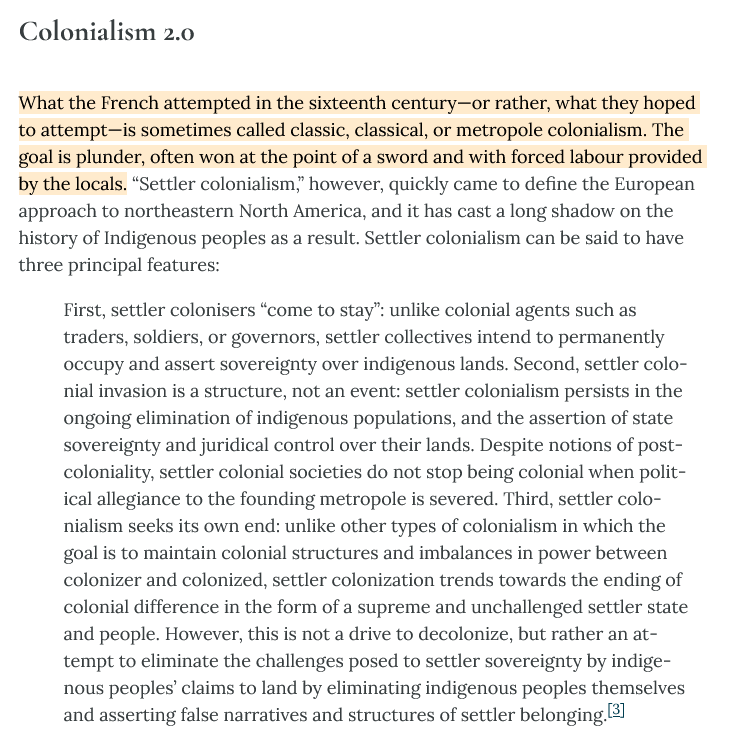
In classical colonial societies, independence was declared which put the colonized in power BUT, direct colonial rule was replaced by the rule of capital (global trade, International Monetary Fund, United Nations, trade agreements, etc)
What is ‘classical colonialism’?
True.
It’s whole design was based on the assumption that white Europeans were superior and therefore had the right to take land, resources, and people from other established societies for the gain of their “homeland.”
It cannot exist and has never existed without the pretext of racial domination. The Global North--through slavery, extraction of resources, and ownership of land—built up an incredible advantage over the Global South. This advantage continues to inform global politics to this day.
Capital is created by exploitation, first and foremost, by European colonialism over non-white nations.
You cannot tell the story of capitalism’s development without telling the story of white supremacy and racial exploitation (the great lie of neoliberalism).
True or False: European colonialism is an explicitly white supremacist project.
The late 1600s.
When was white supremacy invented as a category?
![<p><span>“[W]hite supremacy is like carbon monoxide: odourless and tasteless, one only truly understands its effects once they are being suffocated by it. Racism is merely white supremacy in weaponized form, inflicted by one person or group unto another, and often inflicted without malice or ill intent.”</span></p>](https://knowt-user-attachments.s3.amazonaws.com/17ad9a9e-4f26-4fc0-8932-2fbf3a0d15ad.png)
“[W]hite supremacy is like carbon monoxide: odourless and tasteless, one only truly understands its effects once they are being suffocated by it. Racism is merely white supremacy in weaponized form, inflicted by one person or group unto another, and often inflicted without malice or ill intent.”
According to Andray Domise, how is white supremacy like carbon monoxide?
In 2013, a teenage by the name of Trayvon Martin was murdered by a neighbourhood watch volunteer named George Zimmerman in Florida. Zimmerman was acquitted.
Three radical Black organizers — Alicia Garza, Patrisse Cullors, and Opal Tometi — created a Black-centered political movement called #BlackLivesMatter.
The movement grew through 2013 & 2014 with the continued murders of black people at the hands of police.
What event kickstarted the Black Lives Matter movement?
Black Lives Matter is a non-hierarchical, grassroots organization of activists and organizers who act directly against powerful institutions to achieve their goals.
It started as an explicitly American movement, but BLM has chapters all over the world, including here in Canada.
The largest of which is Black Lives Matter Toronto – BLMTO
“The project is now a member-led global network of more than 40 chapters. Our members organize and build local power to intervene in violence inflicted on Black communities by the state and vigilantes.
Black Lives Matter is an ideological and political intervention in a world where Black lives are systematically and intentionally targeted for demise. It is an affirmation of Black folks’ humanity, our contributions to this society, and our resilience in the face of deadly oppression.”
What is the Black Lives Matter movement, and what does it aim to accomplish?
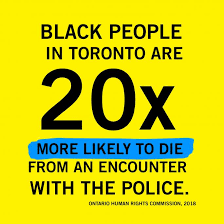
Black Lives Matter Toronto sprung up in response to the shooting death of Andrew Loku by Toronto Police.
BLMTO correctly points out that systemic violence against Black people exists in Canada as well. They staged direct actions against Toronto Police and politicians to protest ‘carding’ and systemic anti-Black racism.
BLMTO is most famous for staging a sit-in at Pride Toronto to protest the marginalization of Queer Blacks within the LGBTQ+ community and the presence of armed and uniformed police at the march.
What event kickstarted the Black Lives Matter movement in Toronto?
Boarding school set up and paid for by the Canadian government, and run by various churches.
Nominally, these schools were set up to educate Indigenous children.
The first official Residential Schools were established in the 1880s
The agenda of Residential Schools went far beyond simply “educating” Indigenous children.
They were set up to kidnap and isolate them from their homes and families and indoctrinate them into “Canadian” society.
They were stripped of their languages, religions, and culture and forcibly inculcated in Euro-Canadian society.
A stark example of settler colonialism continuing after national independence—Residential Schools were set up shortly after the birth of Canada as an independent nation and as the newly-minted country pushed westward toward the Pacific.
The stated goal of Residential Schools according to the churches was to “kill the Indian in the child.”
What are Residential Schools?
False.
Residential Schools were born out of the idea that Canadian culture and society, as evidenced by its European roots, was the pinnacle of human achievement and therefore the “savages” of the New World must be educated and assimilated into civilization.
Many people working with the churches and in Residential Schools truly believed they were going a great thing—God’s work—in ridding Indigenous people of their savage roots.
This belief is how systems of domination take hold.
But, the belief that European civilization is superior is White Supremacy.
This belief still exists today in overt and covert ways.
True or False: Those who worked at churches and in residential schools knew that what they were doing was wrong and actively aimed to inflict harm upon indigenous children.
1996
The Gordon Indian Residential School in Saskatchewan.
The Canadian Government didn’t apologize for the brutal system until 2008.
When was the last Residential School closed in Canada?
Prime Minister John A. McDonald (a virulent racist, even for his time) commissioned journalist and politician Nicholas Flood Davin to study Industrial School in the United States as a means to “civilize the savages in Canada.”
Davin’s report recommended they follow the United States’ example of “aggressive civilization” which led to public funding for the Residential School system.
“If anything is to be done with the Indian, we must catch him very young. The children must be kept constantly within the circle of civilized conditions.” - Nicholas Flood Davin for the 1879 Report on Industrial Schools for Indians and Half-Breeds
How did residential schools start?
Residential Schools reached their zenith across the country in the late 1950s through to the mid 1980s, culminating alongside a project called the Sixties Scoop.
The Sixties Scoops is the nickname for the government/church-led project to remove Indigenous children from their homes en masse and place them in brutal foster care systems. Along with Residential Schools, this project of handing Indigenous children over to white Christian families has been referred to as a Cultural Genocide.
What was the Sixties Scoop?
Reservations are supposedly sovereign areas where First Nations can govern themselves, and while that does happen, reservations exist often on the worst land and extremely rural areas.
Reservations are a form of segregation which continue to marginalize Indigenous people in extreme isolation and often extreme poverty, the likes of which we can barely imagine in the rest of Canada.
First Nations people in Canada today are still relegated largely to reservations.
Several reservations across Canada don’t even have potable drinking water—including one just outside of Toronto.
What are Reservations?
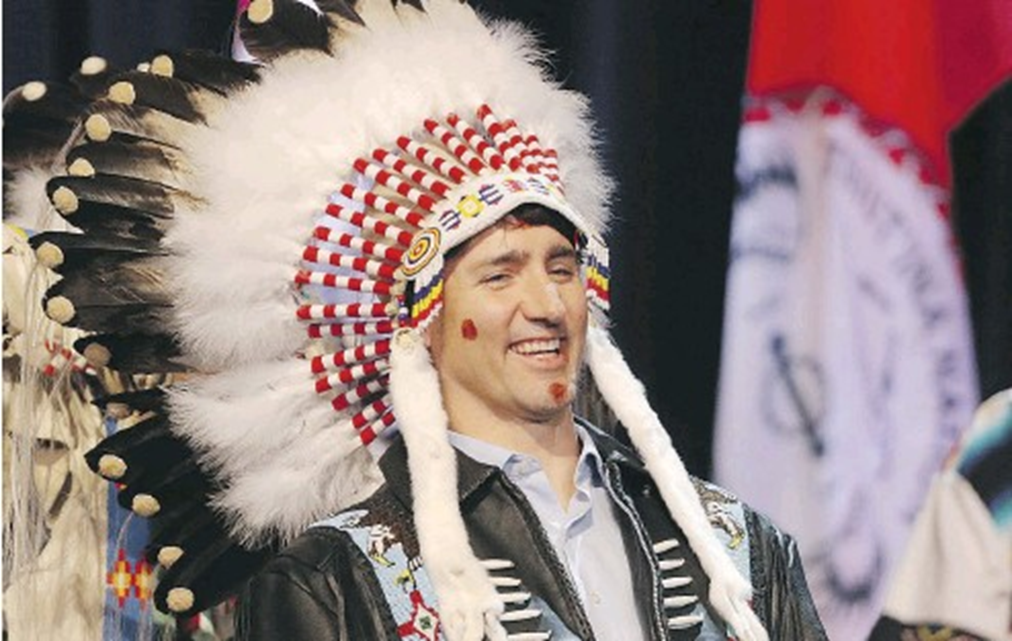
Justin Trudeau has made a political career out of using Indigenous people to further his image as a “progressive.”
In the 2015 election, he ran promising reconciliation for First Nations, Métis, and Inuit people only to ignore that responsibility once he took office.
After years of calling for a public inquiry into Indigenous rights violations in Canada by First Nations activists, Stephen Harper’s Conservatives shut the door for good in 2006 by refusing to fund and execute one.
So, with money raised from First Nations communities across the country, an independent inquiry was established called the Truth and Reconciliation Commission
The Commission lasted from 2008 to 2015 and recommended 94 calls to action which would start the process of reconciliation between Canada and First Nations, Métis, and Inuit people.
Trudeau cynically used the TRC in his 2015 election campaign, promising to implement all 94 actions.
Trudeau has implemented exactly 0 of them in his time in office.
How has Prime Minister Justin Trudeau treated Indigenous peoples before and after being elected into office?
He promised during his campaign to implement all 94 Calls to Action from the Truth & Reconciliation Commission, but so far has failed to uphold even one.
He has promised true reconciliation by upholding continuously broken treaty agreements, but has not—and in fact has broken more with his insistence on building the Trans-Mountain Pipeline—his government purchased it in order to ensure it’s completion.
He promised to make sure that all Canadian reservations had access to clean drinking water but has not implemented a single measure to do so. The problem has gotten worse under his administration. The money his administration has promised falls short of every estimate provided to the Liberals for fixing the problem.
He is steadfastly in favour of oil pipeline projects which break treaty agreements and violate the land rights of First Nations people.
In January 2017, the Canadian Human Rights Tribunal ordered the Trudeau government to take immediate action on under-funding of First Nations child welfare programs, but five non-compliance orders later, they continue to break the law.
In what ways has Justin Trudeau failed Indigenous peoples?
White privilege is the day-to-day result of living in a white supremacist society—the often subtle ways in which life becomes easier or harder based on skin colour. Like white supremacy, this is not always obvious or noticeable.
Whiteness is normalized in society. White people are taught not to recognize white privilege—it becomes an unearned package of assets that whites can cash in at any time.
White people are socialized to simply not see the effects race has on their life the same way men are socialized to not see the effects male privilege has on their lives.
What is ‘white privilege’?
The lay usage of the term usually involves luck or fortune. To be privileged is to be lucky and to benefit from luck and the opportunity it affords.
Seen as a positive outcome of happenstance.
The lay usage of the term privilege can lead to referring to those without privilege as “less fortunate” meaning that their lot in life is out of anyone’s direct control. This obfuscates responsibility and frames acts of charity as acts of kindness from the fortunate to the less fortunate. Charity is framed as optional kindness from those who can offer it.
What is the lay usage of privilege?
“[T]he rights, advantages, and protections enjoyed by some at the expense of and beyond the rights, advantages, and protections available to others.”
The critical/academic usage of the term privilege suggests that it is not the product of luck or happenstance, but the outcome of advantages some groups have over others.
Dominant groups occupy positions of power. Because of this, membership in dominant groups automatically guarantees privilege.
Social and institutional advantages are created which benefit the already dominant in society
For example, the rich, whites, cis-men, heterosexuals, the able-bodied, Christians, etc.
Minoritized groups are “othered” against the assumed dominant position.
What is the critical usage of privilege?
This definition of privilege allows us to see how power impacts minoritized groups or “othered” groups, but THAT DOESN’T MEAN that if you occupy one of these positions that you are a bad person taking advantage of all the things your privilege has afforded.
Privilege, used in this critical sense, is meant to point out institutionalized forms of oppression and power. Institutionalized oppression hurts everyone, even people at the top of the arrangement (think about Teajai’s presentation).
True or False: Being in a privileged position means you are inherently a bad person.
“The advocacy of women's rights on the basis of the equality of the sexes.”
What is ‘feminism’?
19th and early 20th century
The fight for universal suffrage—a.k.a. the right to vote.
Canada, the United States, and United Kingdom
Helped women gain absolute rights (voting, owning property, political candidacy)
Was a movement of mostly wealthy white women.
What are some characteristics of first wave feminism?
Mid-century
The fight for cultural equality
Ending workplace discrimination
Pay-equity
Equal opportunity under capitalism
Often referred to as “Liberal Feminism”
Again, largely a movement of mostly wealthy and middle-class white women.
What are some characteristics of second wave feminism?
Some suggest it minimizes the complexity of feminist movements.
Feminist discourse consists of varying perspectives under the basic notion of gender equality: liberal feminism, post-feminism, radical feminism, Black feminism, Queer feminism, etc.
Not all of these movements are created equal. They have differing goals and differing tactics.
Some are not “feminist” movements at all: Trans-exclusionary radical feminists (TERFs), sex-worker-exclusionary radical feminists (SWERFs), conservative feminists (an oxymoron).
Why do many feminist scholars reject the idea of the wave model of feminism?
Characterized by massiveness and rigidity and total uniformity. “a monolithic society” “a monolithic worldwide movement” undiversified; not diversified. (vocabulary.com)
“In many mainstream cultural circles, feminism is presented as a monolithic movement of bra-burning, man-hating women who do not want equal rights, but a matriarchal society where women have more right than men. This is, of course, nonsense.”
What does viewing feminism as a “monolithic movement” imply?
Argues for women to have equal rights under capitalism: in other words more women in traditional positions of power—CEOs, political leaders, etc.
What is ‘liberal feminism’?
Recognizes that we shouldn’t be striving for more women CEOs, but the abolishment of the entire system of oppression that creates CEOs in the first place. This intertwines it with other anti-oppressive movements and with Critical Theory.
Recognizes that patriarchal institutions are created through the privilege of dominant groups (men), and therefore must question and seek to deconstruct those institutions.
Recognizes that feminism must be not only a movement focused on equal right for women, but it must be antiracist, anti-colonial, and anti-capitalist since institutions in contemporary society marginalize women through multiple forms of oppression (often called intersectional). Racism affects women more than men, capitalism affects women more than men, etc. The systems which dominate the poor and the racialized are the very same systems which oppress women.
What is ‘critical feminism’?
Justin Trudeau proudly wears the ‘feminist’ moniker despite the fact that his government has done little to change the structural issues facing women.
Saying nothing of his government selling arms to Saudi Arabia, a brutally fascist government with a particularly bad record regarding women, who have since used them on their own citizens and millions of people in Yemen.
Trudeau has focused instead on a gender-equal cabinet and marching in the Pride parade—not that those things are bad. They just aren’t enough. They are merely his wearing of the identity.
Strong and robust feminism acknowledges all interlocking forms of oppression and takes in to account issues of race, class, gender expression, and sexuality.
In what ways has Trudeau succeeded or failed in being a feminist?
Understands that someone’s particular cultural standpoint is important in understanding the world.
Standpoint Theory recognizes that oppressed people are in the best position to understand and deconstruct oppressive institutions.
We are less likely to recognize the current of we are being propelled by it.
Women and genderqueer folks live every facet of their lives existing and surviving in a patriarchal society so it is them who must lead in the critique and deconstruction of that world.
The same principle holds for all forms of institutional inequality—race, class, sexuality, ability, etc.
Dominant groups make and benefit from the rules—existing in the “othered” portion of the binary allows for a “bottom-up” understanding of domination.
What is ‘Standpoint Theory’?
Also referred to as Trade Unions or Labour Unions
An organization of workers whose purpose is to maintain or improve the conditions of their employment, such as attaining better wages and benefits, improving working conditions, improving safety standards, establishing complaint procedures, developing rules governing status of employees (rules governing promotions, just-cause conditions for termination) and protecting and increasing the bargaining power of workers.
In other words, a union is the coming together of workers to better their working conditions and lives.
They operate in opposition to Capital.
An old adage from the Industrial Workers of the World (IWW) states: “The working class and the employing class have nothing in common.”
What is a ‘union’?
Once the workers vote to be in a union, the employer is required by law to negotiate in good faith and cannot fire workers for forming a union (although they do all the time in sneaky ways)
In Canada, any worker has the right to form a union with their fellow workers
Unions are organized by workers who already work in the workplace sometimes in collaboration with already existing parent unions.
CBAs govern the structure of the relationship between workers and employers.
They determine pay scales, seniority, grievance processes, working conditions, safety procedures, training, and anything other interaction between the workers and the employers.
CBAs are typically negotiated on the union side by a democratically-elected committee and all agreements must pass a vote of the full membership in order to be ratified.
What is a ‘Collective Bargaining Agreement (CBA)’?
If a union and an employer can’t come to an agreement on a CBA, either initially or after a negotiated CBA expires, they can vote to strike.
An employer can also “lockout” a union if no agreement is met.
The closing of a place of business or a suspension of work by an employer. Lockouts may be used by the employer to pressure the union into agreeing to terms and conditions of employment and sign a collective bargaining agreement. (Canadian Industrial Relations Board)
Strikes and lockouts are types of work stoppages where workers do not work and the employers operate at either part-capacity or not at all. Workers will then publicly demonstrate at or near their place of employment to publicize their struggle against the employers
What is a ‘strike’ or a ‘lockout’?
Closed Shop
Post-Entry Closed Shop
Open Shop
Agency Shop
Craft Union
Industrial Union
General Union
What are seven types of unions?
A workplace where all workers must be a part of the union in order to be employed.
In Canada, this form of unionism was ushered in by The Rand Formula.
What is a ‘closed shop union’?
A type of closed shop where union membership is withheld until after a certain period of time
In Canada, post-entry closed shops typically have a probationary period of 90 days.
What is a ‘post-entry closed shop union’?
A workplace where only some workers are part of the union.
These are only semi-legal in Canada but have been made legal in the U.S. in so-called Right-to-Work States which started to become prevalent in the early 2010s under “Tea Party Republicans.”
In Canada, any hybridized workforce must be negotiated with the union in order to exempt certain workers from union membership.
What is an ‘open shop union’?
A type of open shop where non-union workers must pay a fee for anything they benefit from due to the union (most commonly the collective bargaining process.)
What is an ‘agency shop union’?
Unions organized not by workplace, but by craft (trades such as plumbers, electricians, carpenters, blacksmiths, etc.)
What is a ‘craft union’?
Unions organized not by workplace, but by industry (but not necessarily craft)
Workers may have different jobs or specialties within the industry (Movie and tv production workers, delivery drivers, autoworkers, etc)
What is an ‘industrial union’?
A union that organizes disparate workers across industry
Also may organize unemployed or precariously employed workers
The IWW (Industrial Workers of the World) are a good example of this.
What is a ‘general union’?
Unions raise the living standards of workers across the board.
More predictable schedules
Safer workplaces
More job security
Better benefits
More time off
More autonomy & democracy in the workplace
Union workers in Canada make an average of $5.14/hr more than non-union workers for the same work
In Canada, union membership peaked in the early 1970s at just over 50% of all workers. By the early 1980s that number had fallen to around 40% and now that number is at about 28%
However, public opinion of unions have shot up in recent years as rampant inequality takes hold. It’s expected that the number of unionized workers in Canada will rise up over 30% again in the next five years.
Why are unions important?
Non-union workers also benefit from unions through what’s known as the Union Threat Effect.
The threat of workers joining a union scares employers into upping working conditions, benefits, and pay.
This is especially prevalent in industries where only some employers operate a union shop
Purolater/UPS vs. FedEx
What is the ‘Union Threat Effect’?
Political democracy is something that we “enjoy” here in Canada. Our right to vote and participate in the political process is limited, but not closed off.
We by no means have perfect political democracy (see: Everything), but there is at least some.
Capitalism, however, is an economically fascist or authoritarian system. We must work and earn a living to survive and therefore must put up with authoritarian workplaces that buy our bodies for a period of time every day for 50+ years of our lives.
Unions are an attempt to swing this the other way and give workers some semblance of economic democracy. Unions ARE workers, they are not separate from them. They vote on nearly every aspect of their workplace and have an equal say as their fellow workers in all things (in theory).
Full Economic Democracy however involves taking the union model one step further to workers owning the means of production themselves.
In other words FIRE YOUR BOSS.
What is the difference between Political Democracy and Economic Democracy?
The Haymarket Massacre (Haymarket Riot, Haymarket Affair) took place in Chicago on May 4th, 1886.
Workers were peacefully striking for an 8-hour work day after a worker had been killed and many more injured the day before at the McCormick Harvesting Machine Company.
Someone threw a bomb into the crowd and the ensuing gunfire from police and workers killed four workers and injured many more.
Eight anarchists were charged and convicted, but the OVERWHELMING evidence suggested it was someone acting on behalf of the Machine Company who threw the bomb.
This is widely considered the impetus for May Day, or the International Day of Worker Solidarity.
Describe the Haymarket Massacre.
The Triangle Shirtwaist Factory Fire occurred on March 25, 1911 in Manhattan, NY.
Workers all over the industrialized world were struggling to join unions and were battling their employers for basic human rights.
Routinely, worker uprisings were met with violence from police (state sponsored) and private security firms known as Pinkertons (privately sponsored). This violence led to the injury and death of thousands of workers in the late 19th and early 20th century.
The factory occupied several floors of a Manhattan building known as the Asch Building, located just off of Washington Square Park—one of the wealthiest parts of the entire country.
Workers at the TSF were paid almost nothing (there was no minimum wage in the U.S. at the time), they were densely-packed into the building and surrounded by unsafe, unregulated conditions.
There were about 500 workers.
11 to 12 hour days, six or seven days a week.
Most of the workers were young immigrant women—some as young as 13.
Describe the Triangle Shirtwaist Factory Fire..
Policing in Canada emerged along with Confederation in the mid-1800s with the establishment of local police departments and the Dominion Police in Eastern Canada (Upper Canada, Lower Canada, Maritimes) and the Northwest Mounted Police in Western Canada.
When did policing in Canada emerge?
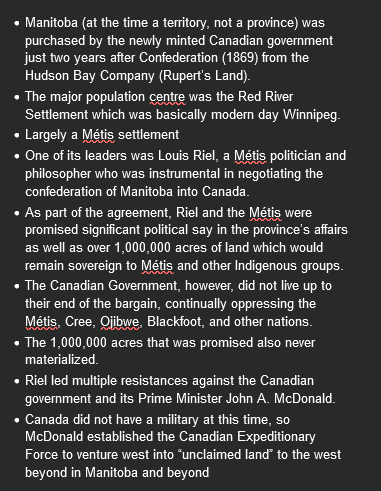
Manitoba (at the time a territory, not a province) was purchased by the newly minted Canadian government just two years after Confederation (1869) from the Hudson Bay Company (Rupert’s Land).
The major population centre was the Red River Settlement which was basically modern day Winnipeg.
Largely a Métis settlement
One of its leaders was Louis Riel, a Métis politician and philosopher who was instrumental in negotiating the confederation of Manitoba into Canada.
As part of the agreement, Riel and the Métis were promised significant political say in the province’s affairs as well as over 1,000,000 acres of land which would remain sovereign to Métis and other Indigenous groups.
The Canadian Government, however, did not live up to their end of the bargain, continually oppressing the Métis, Cree, Ojibwe, Blackfoot, and other nations.
The 1,000,000 acres that was promised also never materialized.
Riel led multiple resistances against the Canadian government and its Prime Minister John A. McDonald.
Canada did not have a military at this time, so McDonald established the Canadian Expeditionary Force to venture west into “unclaimed land” to the west beyond in Manitoba and beyond
Describe the purchase of Manitoba.
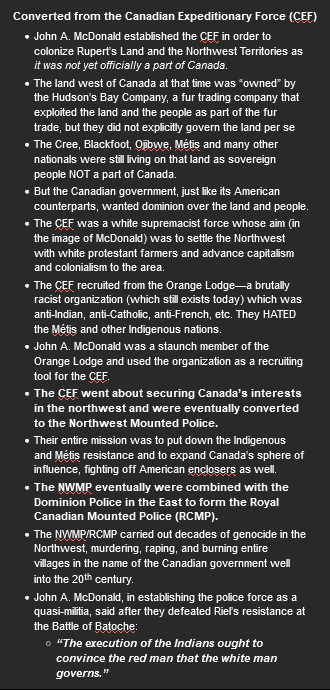
Converted from the Canadian Expeditionary Force (CEF)
John A. McDonald established the CEF in order to colonize Rupert’s Land and the Northwest Territories as it was not yet officially a part of Canada.
The land west of Canada at that time was “owned” by the Hudson’s Bay Company, a fur trading company that exploited the land and the people as part of the fur trade, but they did not explicitly govern the land per se
The Cree, Blackfoot, Ojibwe, Métis and many other nationals were still living on that land as sovereign people NOT a part of Canada.
But the Canadian government, just like its American counterparts, wanted dominion over the land and people.
The CEF was a white supremacist force whose aim (in the image of McDonald) was to settle the Northwest with white protestant farmers and advance capitalism and colonialism to the area.
The CEF recruited from the Orange Lodge—a brutally racist organization (which still exists today) which was anti-Indian, anti-Catholic, anti-French, etc. They HATED the Métis and other Indigenous nations.
John A. McDonald was a staunch member of the Orange Lodge and used the organization as a recruiting tool for the CEF.
The CEF went about securing Canada’s interests in the northwest and were eventually converted to the Northwest Mounted Police.
Their entire mission was to put down the Indigenous and Métis resistance and to expand Canada’s sphere of influence, fighting off American enclosers as well.
The NWMP eventually were combined with the Dominion Police in the East to form the Royal Canadian Mounted Police (RCMP).
The NWMP/RCMP carried out decades of genocide in the Northwest, murdering, raping, and burning entire villages in the name of the Canadian government well into the 20th century.
John A. McDonald, in establishing the police force as a quasi-militia, said after they defeated Riel’s resistance at the Battle of Batoche:
“The execution of the Indians ought to convince the red man that the white man governs.”
How did the Northwest Mounted Police get their start?
Not only does it carry out traditional police activities, but acts as a federal spy agency, drug enforcement agency, and international surveillance agency.
There is no police force in North America with as much power as the RCMP.
Why is the RCMP is unique among police forces?
Canada spends $16.5-billion annually on policing (municipal, provincial, federal)
This number does NOT include the Canadian Security and Intelligence Service (CSIS).
Canadian taxpayers spend $45-million a DAY on policing.
This is BY FAR the most expensive civil service in the country.
In 2024, Windsor will spend $103.58-million on its municipal police force, which accounts for over 21% of its total operating budget.
That’s more than libraries, public transit, housing, public health, and fire services COMBINED.
From 2005-2018, the city saw a decrease in total dollars collected via the tax levy, and has only increase about 21% total since 2005.
The police budget, however has increased 89% during that time.
How much money is put towards funding the police in Canada?
While the U.S. grabs a lot of headlines regarding police killings and overall abuse, Canada’s police have been killing people at all time highs.
In the last decade, police killings in Canada have increased 67%
Black and Indigenous people comprise roughly 10% of the Canadian population, yet some estimates suggest over 30% of all police shootings target one of those groups. And that’s only in cases where the race of the person is actually reported (only about 50% of the total cases.
What are police killings like in Canada?
In just two weeks in August/September of this year, police in Canada killed six Indigenous people, including one right here in Windsor.
In two separate instances, Tammy Bateman and an unnamed 31-year-old man were struck by police vehicle(s) and died.
Steven “Iggy” Dedam was shot and killed by officers after police responded to a call for a wellness check.
A 15-year-old boy named Hoss Lightning was shot and killed by police when he called them for help.
In response to a call involving an assault, the police found the man they believed was responsible, and an altercation ensued. Thus far, there is no indication that he was armed, but he, too, was shot and killed by officers.
Sixties Scoop survivor Jason West died following an “interaction” with law enforcement (Windsor).
What are police killings of indigenous peoples like in Canada?
Police do not prevent crime, they respond to it.
Only 3% of all police work involves investigating or responding to violent crime.
The vast majority of police work deals with petty crime, administrative work, traffic control, accident reporting, or general 911 response.
Even that 3% is almost entirely AFTER the violent crime has taken place
So why do we need people with lethal weapons doing this work? Surely there’s a safer, cheaper alternative.
What do police ACTUALLY do?
Police have only existed in a very small percentage of human history (the last 150ish years) and only were created as an institution to PROTECT PRIVATE PROPERTY under capitalism and advance colonial aims to aid in the influence of capital all over the globe.
This, along with the continued racial violence is why many are calling for the defunding and eventual abolishment of the police.
Why are people calling to defund the police?